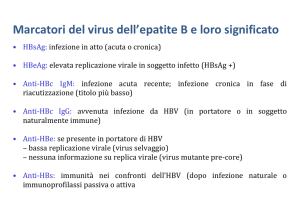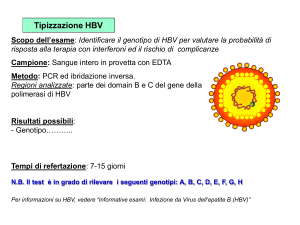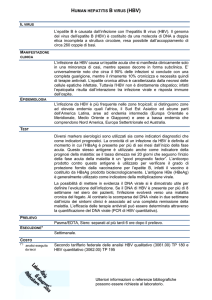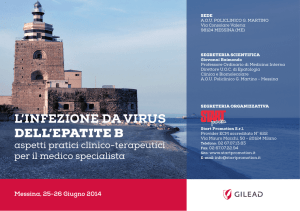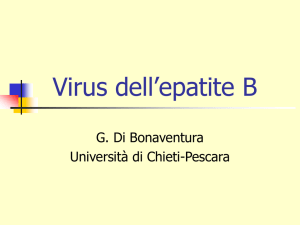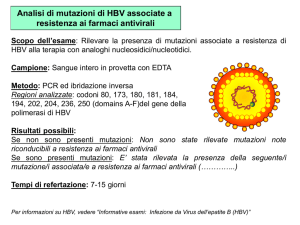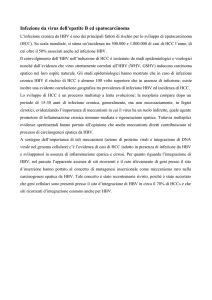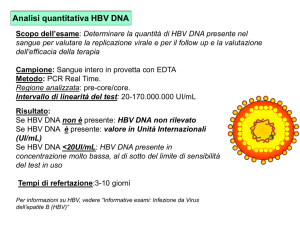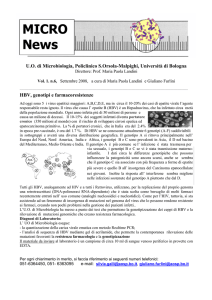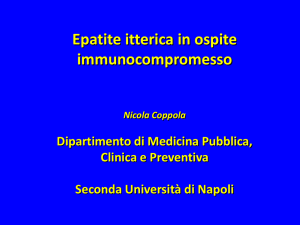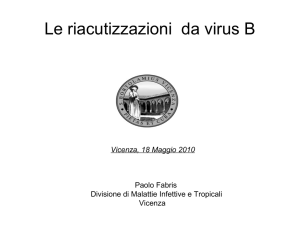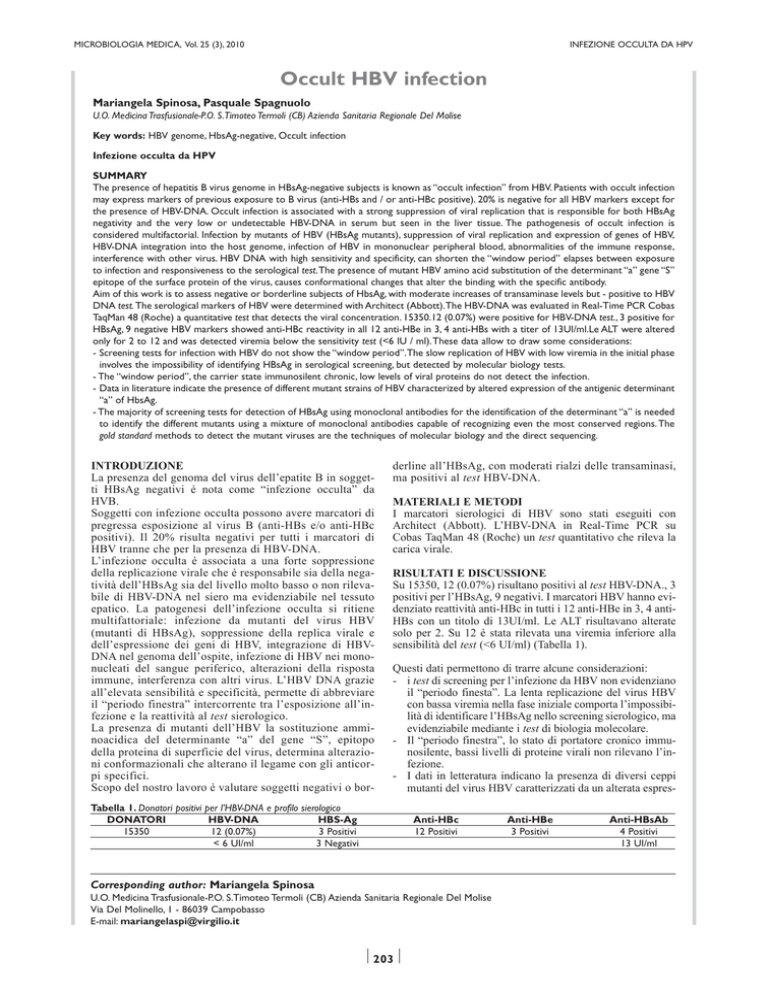
MICROBIOLOGIA MEDICA, Vol. 25 (3), 2010
INFEZIONE OCCULTA DA HPV
Occult HBV infection
Mariangela Spinosa, Pasquale Spagnuolo
U.O. Medicina Trasfusionale-P.O. S.Timoteo Termoli (CB) Azienda Sanitaria Regionale Del Molise
Key words: HBV genome, HbsAg-negative, Occult infection
Infezione occulta da HPV
SUMMARY
The presence of hepatitis B virus genome in HBsAg-negative subjects is known as “occult infection” from HBV. Patients with occult infection
may express markers of previous exposure to B virus (anti-HBs and / or anti-HBc positive). 20% is negative for all HBV markers except for
the presence of HBV-DNA. Occult infection is associated with a strong suppression of viral replication that is responsible for both HBsAg
negativity and the very low or undetectable HBV-DNA in serum but seen in the liver tissue. The pathogenesis of occult infection is
considered multifactorial. Infection by mutants of HBV (HBsAg mutants), suppression of viral replication and expression of genes of HBV,
HBV-DNA integration into the host genome, infection of HBV in mononuclear peripheral blood, abnormalities of the immune response,
interference with other virus. HBV DNA with high sensitivity and specificity, can shorten the “window period” elapses between exposure
to infection and responsiveness to the serological test.The presence of mutant HBV amino acid substitution of the determinant “a” gene “S”
epitope of the surface protein of the virus, causes conformational changes that alter the binding with the specific antibody.
Aim of this work is to assess negative or borderline subjects of HbsAg, with moderate increases of transaminase levels but - positive to HBV
DNA test. The serological markers of HBV were determined with Architect (Abbott).The HBV-DNA was evaluated in Real-Time PCR Cobas
TaqMan 48 (Roche) a quantitative test that detects the viral concentration. 15350.12 (0.07%) were positive for HBV-DNA test., 3 positive for
HBsAg, 9 negative HBV markers showed anti-HBc reactivity in all 12 anti-HBe in 3, 4 anti-HBs with a titer of 13UI/ml.Le ALT were altered
only for 2 to 12 and was detected viremia below the sensitivity test (<6 IU / ml).These data allow to draw some considerations:
- Screening tests for infection with HBV do not show the “window period”.The slow replication of HBV with low viremia in the initial phase
involves the impossibility of identifying HBsAg in serological screening, but detected by molecular biology tests.
- The “window period”, the carrier state immunosilent chronic, low levels of viral proteins do not detect the infection.
- Data in literature indicate the presence of different mutant strains of HBV characterized by altered expression of the antigenic determinant
“a” of HbsAg.
- The majority of screening tests for detection of HBsAg using monoclonal antibodies for the identification of the determinant “a” is needed
to identify the different mutants using a mixture of monoclonal antibodies capable of recognizing even the most conserved regions. The
gold standard methods to detect the mutant viruses are the techniques of molecular biology and the direct sequencing.
INTRODUZIONE
La presenza del genoma del virus dell’epatite B in soggetti HBsAg negativi è nota come “infezione occulta” da
HVB.
Soggetti con infezione occulta possono avere marcatori di
pregressa esposizione al virus B (anti-HBs e/o anti-HBc
positivi). Il 20% risulta negativi per tutti i marcatori di
HBV tranne che per la presenza di HBV-DNA.
L’infezione occulta è associata a una forte soppressione
della replicazione virale che è responsabile sia della negatività dell’HBsAg sia del livello molto basso o non rilevabile di HBV-DNA nel siero ma evidenziabile nel tessuto
epatico. La patogenesi dell’infezione occulta si ritiene
multifattoriale: infezione da mutanti del virus HBV
(mutanti di HBsAg), soppressione della replica virale e
dell’espressione dei geni di HBV, integrazione di HBVDNA nel genoma dell’ospite, infezione di HBV nei mononucleati del sangue periferico, alterazioni della risposta
immune, interferenza con altri virus. L’HBV DNA grazie
all’elevata sensibilità e specificità, permette di abbreviare
il “periodo finestra” intercorrente tra l’esposizione all’infezione e la reattività al test sierologico.
La presenza di mutanti dell’HBV la sostituzione amminoacidica del determinante “a” del gene “S”, epitopo
della proteina di superficie del virus, determina alterazioni conformazionali che alterano il legame con gli anticorpi specifici.
Scopo del nostro lavoro è valutare soggetti negativi o bor-
derline all’HBsAg, con moderati rialzi delle transaminasi,
ma positivi al test HBV-DNA.
MATERIALI E METODI
I marcatori sierologici di HBV sono stati eseguiti con
Architect (Abbott). L’HBV-DNA in Real-Time PCR su
Cobas TaqMan 48 (Roche) un test quantitativo che rileva la
carica virale.
RISULTATI E DISCUSSIONE
Su 15350, 12 (0.07%) risultano positivi al test HBV-DNA., 3
positivi per l’HBsAg, 9 negativi. I marcatori HBV hanno evidenziato reattività anti-HBc in tutti i 12 anti-HBe in 3, 4 antiHBs con un titolo di 13UI/ml. Le ALT risultavano alterate
solo per 2. Su 12 è stata rilevata una viremia inferiore alla
sensibilità del test (<6 UI/ml) (Tabella 1).
Questi dati permettono di trarre alcune considerazioni:
- i test di screening per l’infezione da HBV non evidenziano
il “periodo finesta”. La lenta replicazione del virus HBV
con bassa viremia nella fase iniziale comporta l’impossibilità di identificare l’HBsAg nello screening sierologico, ma
evidenziabile mediante i test di biologia molecolare.
- Il “periodo finestra”, lo stato di portatore cronico immunosilente, bassi livelli di proteine virali non rilevano l’infezione.
- I dati in letteratura indicano la presenza di diversi ceppi
mutanti del virus HBV caratterizzati da un alterata espres-
Tabella 1. Donatori positivi per l’HBV-DNA e profilo sierologico
DONATORI
HBV-DNA
HBS-Ag
15350
12 (0.07%)
3 Positivi
< 6 UI/ml
3 Negativi
Anti-HBc
12 Positivi
Corresponding author: Mariangela Spinosa
U.O. Medicina Trasfusionale-P.O. S.Timoteo Termoli (CB) Azienda Sanitaria Regionale Del Molise
Via Del Molinello, 1 - 86039 Campobasso
E-mail: [email protected]
203
Anti-HBe
3 Positivi
Anti-HBsAb
4 Positivi
13 UI/ml
MICROBIOLOGIA MEDICA, Vol. 25 (3), 2010
SPINOSA M, SPAGNUOLO P.
sione antigenica del determinante “a” dell’HbsAg.
- La maggior parte dei test di screening per la rilevazione
dell’HBsAg utilizza anticorpi monoclonali per l’identificazione del determinante”a”, è necessario per poter identificare i diversi mutanti utilizzare una miscela di anticorpi monoclonali capaci di riconoscere anche le regioni più
conservate. I metodi gold standard per rilevare i virus
mutanti sono le tecniche di biologia molecolare e il
sequenziamento diretto.
BIBLIOGRAFIA
1. Blum HE, Offensperger WB, Walter E, et al. Hepatitis B virus infection
with full-length viral genome in a patient serollogically immune to hepatitis B infection. Liver Lancet 1988; 8: 307-16.
2. Manson AL, Xu L, Guo L, et al. Molecular basis foe persistent hepatitis
Binfection in the liver after clearance of serum hepatis b surface antigen.
Hepatology 1988; 27: 1736-42.
3. Tobenson M, Thomas DL. Occult hepatitis B. Lancet Infect Dis 2002; 2:
479-86.
204

